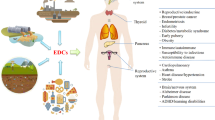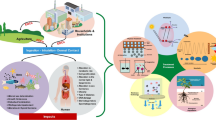Abstract
Polychlorinated biphenyls (PCBs) are global persistent organic pollutants. Almost all commercial PCBs mixtures, single PCB congener, and their metabolites possess endocrine disrupting activities. They can disrupt the estrogen/androgen system, thyroid hormone system and other endocrine systems by interfering with the synthesis, transport, storage, metabolism, and feedback regulation of hormones. The newest data related to the endocrine disrupting activities of PCBs and their mechanisms are reviewed and the research perspectives are also discussed.
Similar content being viewed by others
References
Safe, S. H., Polychlorinated biphenyls (PCBs): Environmental impact, biochemical and toxic responses and implications for risk, Crit. Rev. Toxicol, 1994, 24: 87–149.
Safe, S., Polychlorinated Biphenyls (PCBs): Mammalian and Environmental Toxicology, Germany: Springer-Verlag, 1987, 15–48.
Fischer, L. J., Seegal, R. F., Ganey, P. E. et al., Symposium overview: toxicity of non-coplanar PCBs, Toxicol. Sci., 1998, 41: 49–61.
Bitman, J., Cecil, H. C., Estrogenic activity of DDT and polychlorinated biphenyls, J. Agr. Food. Chem., 1970, 18: 1108–1112.
Korach, K. S., Sarver, P., Chae, K. et al., Estrogen receptor-binding activity of polychlorinated hydroxybiphenyls: conformationally restricted structural probes, Mol. Pharmacol, 1998, 33: 120–126.
Jansen, H. T., Cooke, P. S., Porcelli, J. et al., Estrogenic and anti-estrogenic actions of PCBs in the female rat:in vitro andin vivo studies, Reprod. Toxicol, 1993, 7: 237–248.
Connor, K., Ramamoorthy, K., Moore, M. et al., Hydroxylated polychlorinated biphenyls (PCBs) as estrogens and antiestrogens: structure-activity relationships, Toxicol. Appl. Pharm., 1997, 145: 111–123.
Moore, M., Mustain, M., Daniel, K. et al., Antiestrogenic activity of hydroxylated biphenyl cogeners identified in human serum, Toxicol. Appl. Pharm., 1997, 142: 160–168.
Du, K. J., Chu, S. G., Xu, X. B., Stimulation of MCF-7 cell proliferation by low concentration of Chinese domestic polychlorinated bipohenyls, J. Toxicol. Env. Heal. A, 2000, 61: 101–107.
Andrsson, P. L., Blom, A., Johannisson, A. et al., Assessment of PCBs and hydroxylated PCBs as potential xenoestrogens:in vitro studies based on MCF-7 cell proliferation and induction of vitellogenin in primary culture of rainbow trout hepatocytes, Arch. Environ. Contam. Toxicol., 1999, 37: 145–150.
Arcaro, K. F., Yi, L., Seegal, R. F. et al., 2,2′,6,6′-Tetrachlorobiphenyls is estrogenicin vitro andin vivo, J. Cell. Biochem., 1999, 72: 94–102.
Vakharia, D., Gierthy, J., Rapid assay for oestrogen receptor binding to PCB metabolites, Toxicol.in vitro, 1999, 13: 175–182.
Vakharia, D., Gierthy, J., Use of a combined human liver microsome-estrogen receptor binding assay to assess potential estrogen modulating activity of PCB metabolites, Toxicol. Lett., 2000, 114: 555–565.
Bergeron, J. M., Crews, D., Maclachlan, J. A., PCBs as environmental estrogens: turtle sex determination as a biomarker of environmental contamination, Environ. Health. Persp., 1994, 102: 780–781.
Qin, Z. F., Zhou, J. M., Chu, S. G. et al., Effects of Chinese domestic polychlorinated biphenyls (PCBs) on gonadal differentiation inXenopus laevis, Environ. Health. Persp., 2003, 114: 553–556.
Fang, C. G., Zhang, C. Q., Qiao, H. L. et al., Sexual difference in gonadal development of embryonic chickens after treatment of polychlorinated biphenyls, Chinese Science Bulletin, 2001, 46: 1900–1903.
Reeder, A. L., Foley, G. L., Nichols, D. K. et al., Forms and prevalence of intersexuality and effects of environmental contaminants on sexuality in cricket frogs (Acris crepitans), Environ. Health. Persp., 1998, 106: 261–266.
Matta, M. B., Cairncross, C., Kocan, R. M., Possible effects of polychlorinated biphenyl on sex determination in rainbow trout, Environ. Toxicol. Chem., 1998, 17: 26–29.
Schrader, T. J., Cooke, G. M., Effects of Aroclors and individual PCB congeners on activation of the human androgen receptorin vitro, Reprod. Toxicol., 2003, 17: 15–23.
Bonefold-Jorgensen, E., Andersen, A., Rasmussen, T. et al., Effect of highly bioaccumulated polychlorinated biphenyl congeners on estrogen and androgen receptor activity, Toxicology, 2001, 158: 141–153.
Kramer, V. J., Helferich, W. G., Bergman, A. et al., Hydroxylated polychlorinated biphenyl metabolites are anti-estrogenic in a stably transfected human breast adenocarcinoma (MCF-7) cell line, Toxicol. Appl. Pharm., 1997, 144: 363–376.
Hansen, L. G., Stepping backward to improve assessment of PCB congener toxicities, Environ. Health. Persp., 1998, 106(suppl. 1): 171–189.
Zhu, B. T., Conney, A. H., Functional role of estrogen metabolism in target cells: review and perspectives, Carcinogenesis, 1998, 19: 1–27.
Drenth, H. J., Bouwman, C. A., Seinen, W. et al., Effects of some persistent halogenated environmental contaminants on aromatase (CYP19) activity in the human choriocarcinoma cell line JEG-3, Toxicol. Appl. Pharm., 1998, 148: 50–55.
Brouwer, A., Longnecker, M. P., Birnbaum, L. S. et al., Characterization of potential endocrine-related health effects at low-dose levels of exposure to PCBs, Environ. Health. Persp, 1999, 107(suppl. 4): 639–649.
Kester, M. A., Potent inhibition of estrogen sulfotransferase by hydroxylated PCB metabolites: a novel pathway explaining the estrogenic activity of PCBs, Endocrinology, 2000, 141: 1897–1900.
Khan, I. A., Mathews, S., Okuzawa, K. et al., Alterations in the GnRH-LH system in relation to gonadal stage and Aroclor 1254 exposure in Atlantic croaker, Comp. Biochem. Phys. B, 2001, 129: 251–259.
Collins, W. J., Capen, C. C., Kasza, L. et al., Effect of polychlorinated biphenyl (PCB) on the thyroid gland of rats, Am. J. Pathol., 1977, 89: 119–136.
Ness, D. K., Schantz, S. L., Moshtaghian, J. et al., Effects of perinatal exposure to specific PCB-congeners on thyroid hormone concentrations and thyroid histology in the rat, Toxicol. Lett., 1993, 68: 311–323.
Langer, P., Polychlorinated biphenyls and the thyroid gland, Endocr. Regulat., 1998, 32: 193–203.
Kohn, M. C., Sewall, C. H., Lucier, G. W. et al., A mechanistic model of effects of dioxin on thyroid hormone in the rat, Toxicol. Appl. Pharm., 1996, 136: 29–48.
Vsser, D. C., Kaptein, E., Van Raay, J. et al., Glucuronidation of thyroid hormone in rat liver: effects ofin vivo treatment with microsomal enzyme inducers andin vitro assay conditions, Endocrinology, 1993, 133: 2177–2186.
Schuur, A. G., Legger, F. F., Van Meeteren, M. E. et al., In vitro inhibition of thyroid hormone sulfation by hydroxylated metabolites of halogenated aromatic hydrocarbons, Chem. Res. Toxicol., 1998, 11: 1075–1081.
Cheek, A. O., Kow, K., Chen, J. et al., Potential mechanisms of thyroid disruption in humans: interaction of organachlorine compounds with thyroid receptor, transthyretin, and thyroid-binding globulin, Environ. Health. Persp., 1999, 107: 273–278.
Morse, D. C., Klasson-Wehler, E., Wesseling, W. et al., Alterations in rat brain thyroid status following pre and postnatal exposure to polychlorinated biphenyls (Aroclor 1254), Toxicol. Appl. Pharm., 1996, 136: 269–279.
Darnerud, P. O., Morse, D. C., Klasson-Wehler, E. et al., Binding of a 3,3′,4,4′-tetrachlorobiphenyl (CB77) metabolite to fetal transthyretin and effects on fetal thyroid hormone levels in mice, Toxicology, 1996, 106: 105–114.
Khan, M. A., Lichtensteiger, C. A., Faroon, O. et al., The hypothalamo-pituitary-thyroid (HPT) axis: a target of nonpersistentor-tho-substituted PCB congener, Toxicol. Sci., 2002, 65: 52–61.
Khan, M. A., Hansen, L. G., Ortho-substituted polychlorinated biphenyl (PCB) congeners (95 or 101) decrease pituitary response to thyrotropin releasing hormone, Toxicol. Lett., 2003, 144: 173–182.
Mckinney, J. D., Multifunctional receptor model for dioxin and related compound toxic action: possible thyroid hormone-responsive effect-linked site, Environ. Health. Persp., 1989, 82: 323–336.
Iwasaki, T., Miyazaki, W., Takeshita, A. et al., Polychlorinated biphenyls suppress thyroid hormone-induced transactivation, Biochem. Biophys. Res. Commun., 2002, 299: 384–388.
Author information
Authors and Affiliations
Corresponding author
About this article
Cite this article
Zhou, J., Qin, Z., Lin, C. et al. Research progress of the endocrine disrupting activities of polychlorinated biphenyls. Chin.Sci.Bull. 49, 215–219 (2004). https://doi.org/10.1007/BF03182800
Received:
Accepted:
Issue Date:
DOI: https://doi.org/10.1007/BF03182800




